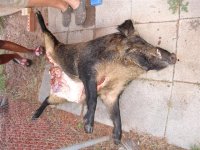2damnold4this
New member
2old... No actually farm pigs are intentionally fattened for higher weight on the sale barn scale and juicier meat. Wild swine is VERY lean and will dry out and toughen if over cooked even the least little bit...
Hardly any fat.
All pork dries out if it's over cooked.
Until recently, breeds of hogs called lard hogs were favored by Americans with meat hogs and bacon hogs coming second and third respectively. Lard hogs had the most fat, bacon hogs the second most and meat hogs the least. Most hogs in the US today are the Hampshire breed of meat hog, the pig with the lowest fat content. I'd expect that most feral hogs would be interbreeds of lard hogs, meat hogs and bacon hogs that escaped over the years and would have a higher fat content in the muscle tissue than the pure bred meat hog though they might not have as much fat in other areas of their body due to poor nutrition.
Hardly any fat.
All pork dries out if it's over cooked.
Until recently, breeds of hogs called lard hogs were favored by Americans with meat hogs and bacon hogs coming second and third respectively. Lard hogs had the most fat, bacon hogs the second most and meat hogs the least. Most hogs in the US today are the Hampshire breed of meat hog, the pig with the lowest fat content. I'd expect that most feral hogs would be interbreeds of lard hogs, meat hogs and bacon hogs that escaped over the years and would have a higher fat content in the muscle tissue than the pure bred meat hog though they might not have as much fat in other areas of their body due to poor nutrition.

